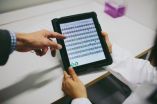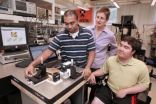(Press-News.org) CORVALLIS, Ore. – The vast reservoir of carbon stored in Arctic permafrost is gradually being converted to carbon dioxide (CO2) after entering the freshwater system in a process thought to be controlled largely by microbial activity.
However, a new study – funded by the National Science Foundation and published this week in the journal Science – concludes that sunlight and not bacteria is the key to triggering the production of CO2 from material released by Arctic soils.
The finding is particularly important, scientists say, because climate change could affect when and how permafrost is thawed, which begins the process of converting the organic carbon into CO2.
"Arctic permafrost contains about half of all the organic carbon trapped in soil on the entire Earth – and equals an amount twice of that in the atmosphere," said Byron Crump, an Oregon State University microbial ecologist and co-author on the Science study. "This represents a major change in thinking about how the carbon cycle works in the Arctic."
Converting soil carbon to carbon dioxide is a two-step process, notes Rose Cory, an assistant professor of earth and environmental sciences at the University of Michigan, and lead author on the study. First, the permafrost soil has to thaw and then bacteria must turn the carbon into greenhouse gases – carbon dioxide or methane. While much of this conversion process takes place in the soil, a large amount of carbon is washed out of the soils and into rivers and lakes, she said.
"It turns out, that in Arctic rivers and lakes, sunlight is faster than bacteria at turning organic carbon into CO2," Cory said. "This new understanding is really critical because if we want to get the right answer about how the warming Arctic may feedback to influence the rest of the world, we have to understand the controls on carbon cycling.
"In other words, if we only consider what the bacteria are doing, we'll get the wrong answer about how much CO2 may eventually be released from Arctic soils," Cory added.
The research team measured the speed at which both bacteria and sunlight converted dissolved organic carbon into carbon dioxide in all types of rivers and lakes in the Alaskan Arctic, from glacial-fed rivers draining the Brooks Range to tannin-stained lakes on the coastal plain. Measuring these processes is important, the scientists noted, because bacteria types and activities are variable and the amount of sunlight that reaches the carbon sources can differ by body of water.
In virtually all of the freshwater systems they measured, however, sunlight was always faster than bacteria at converting the organic carbon into CO2.
"This is because most of the fresh water in the Arctic is shallow, meaning sunlight can reach the bottom of any river – and most lakes – so that no dissolved organic carbon is kept in the dark," said Crump, an associate professor in Oregon State's College of Earth, Ocean, and Atmospheric Sciences. "Also, there is little shading of rivers and lakes in the Arctic because there are no trees."
Another factor limiting the microbial contribution is that bacteria grow more slowly in these cold, nutrient-rich waters.
"Light, therefore, can have a tremendous effect on organic matter," University of Michigan's Cory pointed out.
The source of all of this organic carbon is primarily tundra plants – and it has been building up for hundreds of thousands of years, but doesn't completely break down immediately because of the Arctic's cold temperatures. Once the plant material gets deep enough into the soil, the degradation stops and it becomes preserved, much like peat.
"The level of thawing only gets to be a foot deep or so, even in the summer," Crump said. "Right now, the thaw begins not long before the summer solstice. If the seasons begin to shift with climate change – and the thaw begins earlier, exposing the organic carbon from permafrost to more sunlight – it could potentially trigger the release of more CO2."
The science community has not yet been able to accurately calculate how much organic carbon from the permafrost is being converted into CO2, and thus it will be difficult to monitor potential changes because of climate change, they acknowledge.
"We have to assume that as more material thaws and enters Arctic lakes and rivers, more will be converted to CO2," Crump said. "The challenge is how to quantify that."
Some of the data for the study was made available through the National Science Foundation's Arctic Long-Term Ecological Research project, which has operated in the Arctic for nearly 30 years.
INFORMATION:
Other authors on the study are Collin Ward and George Kling of the University of Michigan.
Photos are available to illustrate this story at the links below:
Byron Crump, Oregon State University, samples an Arctic lake: https://flic.kr/p/oPepGv
Organic matter from the tundra enters an Arctic lake: https://flic.kr/p/oPdStP
Rose Cory, University of Michigan, samples an Arctic river: https://flic.kr/p/oMcaNf END
Sunlight, not microbes, key to CO2 in Arctic
2014-08-21
ELSE PRESS RELEASES FROM THIS DATE:
A novel 'man and machine' decision support system makes malaria diagnostics more effective
2014-08-21
A Finnish-Swedish research group at the Institute for Molecular Medicine Finland (FIMM), University of Helsinki, and Karolinska institutet, Stockholm, has developed a novel "man and machine" decision support system for diagnosing malaria infection. This innovative diagnostic aid was described in PLOS One scientific journal today, 21 August. The method is based on computer vision algorithms similar to those used in facial recognition systems combined with visualization of only the diagnostically most relevant areas. Tablet computers can be utilized in viewing the images.
In ...
Scientists observe quantum vortices in cold helium droplets
2014-08-21
An international research team including DESY scientists has observed tiny quantum vortices in cold droplets of liquid helium. The team reports in the journal Science that the exotic vortices arrange themselves as densely packed lattices inside the nanodroplets. It is the first time that the quantum vortices, which have already been observed in larger samples of what is known as superfluid helium, have been detected in nanodroplets. "The experiment has exceeded our best expectations," says Andrey Vilesov of the University of Southern California, one of the experiment's ...
Hot-spring bacteria reveal ability to use far-red light for photosynthesis
2014-08-21
Bacteria growing in near darkness use a previously unknown process for harvesting energy and producing oxygen from sunlight, a research team led by a Penn State University scientist has discovered. The discovery lays the foundation for further research aimed at improving plant growth, harvesting energy from the Sun, and understanding dense blooms like those now occurring on Lake Erie and other lakes worldwide. A paper describing the discovery will be published in the Science Express edition of the journal Science on 21 August 2014.
"We have shown that some cyanobacteria, ...
New DNA test for diagnosing diseases linked to childhood blindness
2014-08-21
SAN FRANCISCO – Aug. 21, 2014 – Researchers in the United Kingdom have demonstrated that advanced DNA testing for congenital cataracts can quickly and accurately diagnose a number of rare diseases marked by childhood blindness, according to a study published online today in Ophthalmology, the journal of the American Academy of Ophthalmology. Using a single test, doctors were able to tailor care specifically to a child's condition based on their mutations reducing the time and money spent on diagnosis and enabling earlier treatment and genetic counseling.
Each year, ...
USC Eye Institute study shows Native American ancestry a risk factor for eye disease
2014-08-21
LOS ANGELES — New research led by the University of Southern California (USC) Eye Institute, part of Keck Medicine of USC, shows for the first time that Native American ancestry is a significant risk factor for vision-threatening diabetic retinopathy among Latinos with Type 2 diabetes. Diabetic retinopathy is the leading cause of blindness in working-age adults in the United States, affecting more than 4 million Americans age 40 and older.
The research was published online today in Investigative Ophthalmology & Visual Science, the peer-reviewed academic journal of The ...
Novel recycling methods: The fluorescent fingerprint of plastics
2014-08-21
Researchers at Ludwig-Maximilians-Universitaet (LMU) in Munich have developed a new process which will greatly simplify the process of sorting plastics in recycling plants. The method enables automated identification of polymers, facilitating rapid separation of plastics for re-use.
A team of researchers led by Professor Heinz Langhals of LMU's Department of Chemistry has taken a significant step which promises to markedly expedite the recycling of plastic waste. They have developed a technique which provides for automated recognition of their polymer constituents, thus ...
CHEST releases new expert guidance in care of the critically ill and injured
2014-08-21
The American College of Chest Physicians (CHEST) announces the immediate release of Care of the Critically Ill and Injured During Pandemics and Disasters: CHEST Consensus Statement today in the Online First section of the journal CHEST while the global health-care community cares for patients with the Ebola virus. The consensus statement aims to guide ethical decision-making, coordination of care, resource conservation, and research in crises. The statement was developed by over 100 clinicians and experts representing a broad variety and scope of clinical fields from more ...
Laser device may end pin pricks, improve quality of life for diabetics
2014-08-21
Princeton University researchers have developed a way to use a laser to measure people's blood sugar, and, with more work to shrink the laser system to a portable size, the technique could allow diabetics to check their condition without pricking themselves to draw blood.
"We are working hard to turn engineering solutions into useful tools for people to use in their daily lives," said Claire Gmachl, the Eugene Higgins Professor of Electrical Engineering and the project's senior researcher. "With this work we hope to improve the lives of many diabetes sufferers who depend ...
Objectification in romantic relationships related to sexual pressure and coercion
2014-08-21
To sexually objectify a woman is to focus on her body in terms of how it can provide sexual pleasure rather than viewing her as a complete human being with thoughts and feelings. While objectification has long been considered a problem in the media, how does it affect individual romantic relationships? New research published in Psychology of Women Quarterly, a SAGE journal, finds that more objectification of a female partner's body is related to higher incidents of sexual pressure and coercion.
Researchers Laura R. Ramsey and Tiffany Hoyt surveyed 119 males and 162 females ...
Primary care physicians can be critical resource for abused women in rural areas
2014-08-21
Many primary care physicians in rural communities do not routinely screen women for intimate partner violence (IPV), according to Penn State medical and public health researchers. Rural women who are exposed to such violence have limited resources if they seek help.
"Rural health care providers are uniquely positioned to help women," said Jennifer S. McCall-Hosenfeld, a primary care physician and assistant professor of medicine and public health sciences, Penn State College of Medicine. "However, in rural settings, it might be even more important for physicians to step ...



